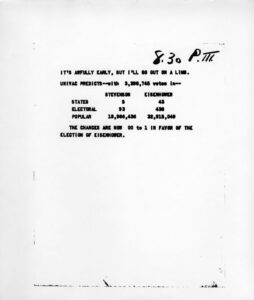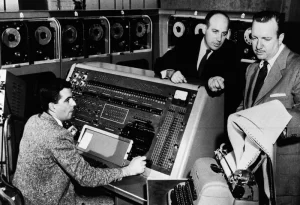Computer First Predicts Presidential Election
As part of a publicity stunt to help boost sales, Remington Rand collaborates with CBS to have its UNIVAC computer predict the results of the 1952 US presidential election between Dwight Eisenhower and Adlai Stevenson live on air. Because the pre-election polls had the election very close, the publicity surrounding a computer predicting the winner generated a lot of popular interest.
UNIVAC correctly predicted a landslide victory by Eisenhower early in the evening after only 3 million votes had been returned and entered into the system. However, because it was so different than the expected result, the decision was made to hold back the computerized prediction. It appears that both Remington Rand and CBS feared the computer was incorrect so they didn’t want to take the risk. It was only late in the broadcast when continuing returns seemed to indicate that UNIVAC was in fact correct, did CBS announce the landslide prediction from the computer and the fact it had done so hours earlier. In the end, UNIVAC had come within 3.5% of the popular vote, within 4 electoral votes, and predicted 100-1 odds of the Eisenhower victory.
 The publicity stunt worked as UNIVAC became relatively famous. For a time people started calling all computers “UNIVACs”, it was featured on the cover of a Superman comic book, and in a Looney Toons cartoon. By the next presidential election 4 years later, all 3 major networks were using computers to predict the results.
The publicity stunt worked as UNIVAC became relatively famous. For a time people started calling all computers “UNIVACs”, it was featured on the cover of a Superman comic book, and in a Looney Toons cartoon. By the next presidential election 4 years later, all 3 major networks were using computers to predict the results.

